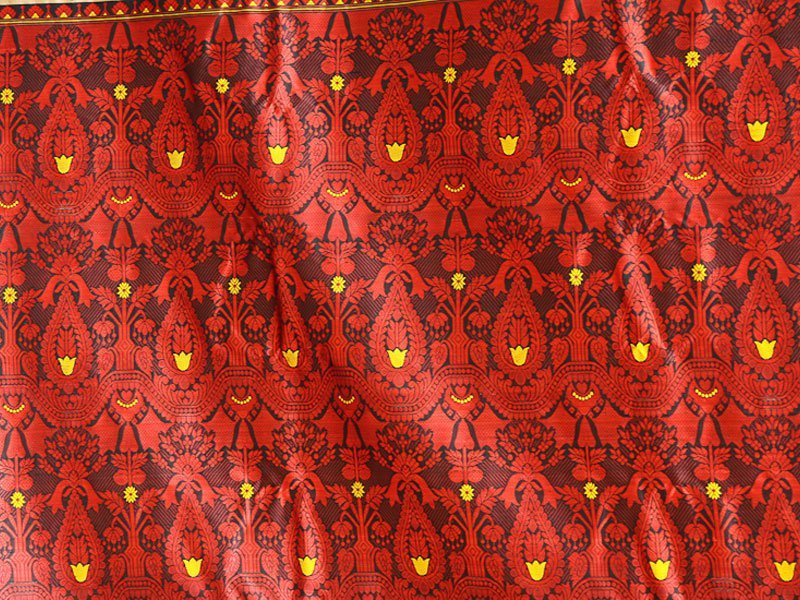
Introduction
Nestled in the northeastern state of Assam, India, lies a quaint little town called Sualkuchi, often referred to as the “Manchester of the East.” Renowned for its exceptional handloom and silk weaving traditions, Sualkuchi is a treasure trove of heritage and craftsmanship. This picturesque village, situated about 30 km from Guwahati and resting on the banks of the majestic river Brahmaputra, has earned various monikers, including “Silk-haven” and “Manchester of Assam.” In this comprehensive article, we embark on a journey into the rich tapestry of Sualkuchi weaving, exploring its historical significance, artistic techniques, cultural impact, challenges, and the path forward.
Table of Contents
The Legacy of Sualkuchi Weaving: A Historical Journey
The roots of Sualkuchi’s weaving heritage stretch back to ancient times. Historical records suggest that the craft was introduced by the Tai-Ahoms, who migrated to Assam from Yunnan, China, during the 13th century. Over the centuries, Sualkuchi’s weavers honed their skills, passing down their techniques from one generation to the next. Today, the art of weaving has become an integral part of Assam’s cultural identity, reflecting its enduring beauty and significance.
The Art of Muga Silk: Elegance in Golden Threads
At the heart of Sualkuchi’s weaving tradition lies the exquisite Muga silk, a textile of unparalleled beauty and significance. Muga silk stands apart with its natural golden hue and exceptional sheen, attributes that distinguish it from other silk varieties. The silk is derived from the cocoons of the native Assam silk moth, Antheraea assamensis, making it a rare and highly valued material. Muga silk becomes even more lustrous with each wash, a testament to its enduring quality.
The Weaving Process: A Symphony of Threads
The journey of Sualkuchi silk begins with the cultivation of mulberry plantations to rear silkworms for the fine Mulberry silk. The village’s artisans also produce Eri silk, known for its warmth and comfort, by nurturing silkworms that feed on castor leaves. The weaving process in Sualkuchi is a manual art form, where skillful weavers operate looms handed down through generations. Traditional tools like bamboo reeds, shuttles, and bobbins are wielded with mastery to create intricate patterns and designs that embody the essence of Sualkuchi’s heritage.
Popular Sualkuchi Motifs





Photos/Dsource
Dyeing and Designing: Colors of Tradition
Following the weaving process, the fabric undergoes an elaborate dyeing ritual. Sualkuchi artisans prefer the use of natural dyes sourced from various plants and minerals, adding an eco-friendly dimension to their creations. The dyed fabric is then meticulously adorned using tie-dye, resist-dye, or hand-painting techniques. Each method contributes to the birth of unique and mesmerizing patterns that grace Sualkuchi textiles.
Sualkuchi Weaving Saree


Photo/Houseofelegance
The Socio-Cultural Impact: Empowering Artisans, Preserving Heritage
Sualkuchi’s weaving industry serves as a significant source of livelihood for local communities. The craft provides employment opportunities to numerous weavers and artisans, enabling them to thrive economically while safeguarding their cultural heritage. The textiles woven in Sualkuchi hold deep cultural significance, seamlessly woven into traditional ceremonies, festivals, and weddings, making them an integral part of Assamese culture and celebrations.
Challenges and Opportunities: Navigating Modernization
The age-old art of Sualkuchi weaving faces challenges in the modern era. The introduction of modern technology and power looms presents a dichotomy between preserving tradition and embracing innovation. Striking a harmonious balance between these elements is essential to ensure the craft’s survival and continuity for future generations.
Market Expansion: Weaving Across Borders
Efforts are underway to elevate Sualkuchi textiles onto the global stage. By embracing international markets and harnessing the potential of e-commerce platforms, the industry aims to expand its reach and kindle a demand for these exceptional textiles worldwide.
Conclusion: A Tapestry of Timeless Beauty
Sualkuchi weaving stands as a testament to Assam’s rich cultural heritage. The intricate designs, vibrant colors, and masterful craftsmanship of Sualkuchi textiles illuminate the village’s enduring legacy. Each thread woven by skilled artisans carries forward a tradition that has withstood the test of time, bridging past and present. As we celebrate the artistry of Sualkuchi weaving, we honor the weavers who infuse life into these fabrics, safeguarding an art form that continues to captivate hearts across the globe.
Also Read- India-Karnataka: Banjara Embroidery
FAQs About Sualkuchi Weaving
- What Makes Muga Silk Unique? Muga silk is celebrated for its natural golden hue and unmatched sheen, setting it apart from other silk varieties.
- How Are Sualkuchi Textiles Dyed? Sualkuchi textiles undergo dyeing using natural dyes extracted from diverse plants and minerals, underlining their commitment to eco-friendliness.
- Why is Sualkuchi Known as the “Manchester of the East”? Sualkuchi earned this moniker due to its historical significance as a prominent hub for silk weaving and textile production in the eastern region.
- How Are Weaving Skills Passed Down in Sualkuchi? Weavers in Sualkuchi uphold the age-old tradition of transferring weaving techniques from parents to their offspring, ensuring the timeless continuity of this remarkable art form.
- What Challenges Does the Sualkuchi Weaving Industry Face Today? The Sualkuchi weaving industry grapples with the modernization dilemma, striving to strike a harmonious balance between preserving heritage and embracing technological advancements.
In the embrace of Sualkuchi’s enchanting textiles, we find a captivating fusion of tradition and creativity, a legacy that continues to weave stories for generations to come.
Having read this I believed it was rather informative. I appreciate you taking the time and energy to put this content together. I once again find myself spending a significant amount of time both reading and commenting. But so what, it was still worth it!